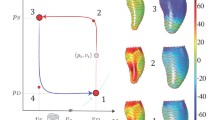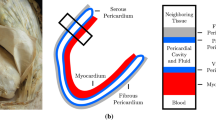Abstract
A thorough understanding of ventricular interaction and the effects of septal function on right and left ventricular performance in the human heart requires measurement of interventricular pressure gradients using high fidelity pressure transducers. The advent of newer echocardiographic techniques provides an opportunity to combine high resolution images with bi-ventricular catheterization data in the cardiac catheterization laboratory, and obtain the detailed hemodynamic and echocardiographic information necessary to more fully understand the clinical manifestations of normal and abnormal septal and free wall mechanical function. We have anticipated these developments and modified the description of heart mechanics in our integrated multi-scale model of the human cardio-respiratory system (H-CRS) to closely analyze how the mechanical properties of the inter-ventricular septum affect the work, energy utilization, and oxygen consumption of the atria, ventricles, septum, and each ventricular free wall. Combined with the H-CRS model, these modifications allow one to observe how tissue properties of the septum affect the entire heart and circulation. For example, the normal septum transfers energy from the left to the right ventricle, and assists the pre-load of both, acting as a third pump. Diseases that increase septal elastance cause abnormalities resembling left ventricular diastolic dysfunction (LVDD), including a decrease in cardiac output and an increase in pulmonary pressures despite a normal left ventricular ejection fraction. Similar applications of the H-CRS model to other regional disorders such as hypertrophic obstructive cardiomyopathy and myocardial infarction might likewise allow one to study their clinical implications in greater detail.









Similar content being viewed by others
References
Bruce JC, Packer DL, Seward JB. Intracardiac Doppler hemodynamics, flow New vector, phased array ultrasound tipped catheter. Amer J Cardiol. 1999;83:1509–12.
Chung DC, Niranjan SC, Clark JW, Bidani A, Johnston WE, Zwischenberger JB, et al. A dynamic model of ventricular interaction and pericardial influence. Am J Physiol Heart Circ Physiol. 1997;272:2942–62.
Luo C, Ware DL, Zwischenberger JB, Clark JW. Using a human cardiopulmonary model to study and predict normal and diseased ventricular mechanics, septal interaction, and atrio-ventricular blood flow patterns. J Cardiovasc Eng. 2007;7:17–31.
Murgo JP, Westerhof N, Giolma JP, Altobelli SA. Aortic input impedance in normal man: relationship to pressure wave forms. Circulation Res. 1980;62:105–16.
Ren JF, Schwartzman D, Callans DJ, Brode SE, Gottlieb CD, Marchlinski FE. Intracardiac echocardiography (9 MHz) in humans: methods, imaging views and clinical utility. Ultrasound Med Biol. 1999;25:1077–86.
Suga H. Total mechanical energy of a ventricular model and cardiac oxygen consumption. AJP. 1979a;236:H498–505.
Suga H. External mechanical work from relaxing ventricle. AJP. 1979b;236:H494–7.
Suga H. Ventricular energetics. Physiol Rev. 1990;70:247–77.
Suga H, Hayashi T, Suehiro S, Hisano R, Shirahata M, Ninomiya I. Equal Oxygen consumption rates of isovolumic and ejecting contractions with equal systolic pressure-volume areas in canine left ventricle. Circulation Res. 1981;49:1082–91.
Suga H, Ryuichi H, Hirata S, Takakazu H, Osamu Y, Ninomiya I. Heart rate-independent energetics and systolic pressure-volume area in dog heart. AJP. 1983;244:H206–14.
Takaoka H, Takeuchi M, Odake M, Yokoyama M. Assessment of myocardial oxygen consumption (Vo2) and systolic pressure-volume area (PVA) in human hearts. European Heart J. 1992;13:85–90.
Westerhoff N. Cardiac work and efficiency. Cardiovascular Res. 2000;48:4–7.
Author information
Authors and Affiliations
Corresponding author
Rights and permissions
About this article
Cite this article
Luo, C., Ware, D.L., Zwischenberger, J.B. et al. A Mechanical Model of the Human Heart Relating Septal Function to Myocardial Work and Energy. Cardiovasc Eng 8, 174–184 (2008). https://doi.org/10.1007/s10558-008-9054-z
Published:
Issue Date:
DOI: https://doi.org/10.1007/s10558-008-9054-z




